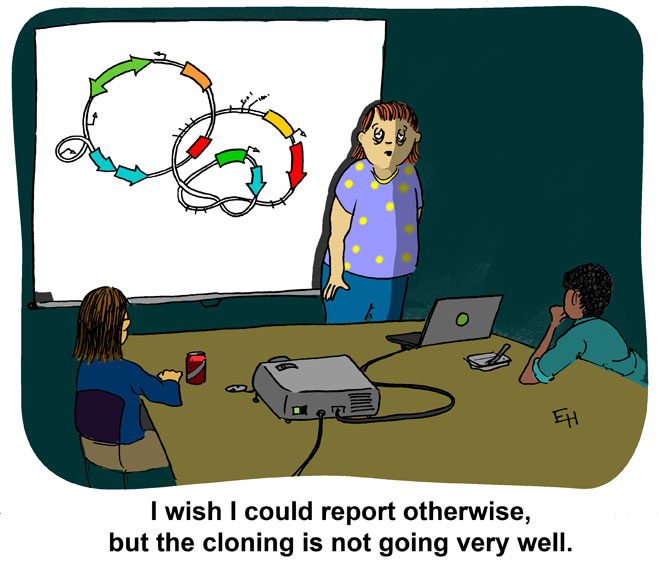
Dephosphorylation of 5´ Ends
If the ends of the prepared cloning vector are identical (e.g., cut with a single restriction enzyme), treat the vector with a phosphatase like TSAP Thermosensitive Alkaline Phosphatase (Cat.# M9910) to remove the phosphate groups from the 5′ ends and prevent self-ligation of the vector. For linear vectors with unique 5′ ends, dephosphorylation is not necessary. The dephosphorylation reaction can be performed directly in restriction enzyme buffer so the vector can be cut and dephosphorylated at the same time.
- As a general guideline, for reactions containing up to 1µg of DNA, add 15 units of restriction enzyme and 1–2µl of TSAP (depending on the reaction buffer used) to the vector DNA in a total reaction volume of 20–50µl. Set up the reaction in the appropriate 1X Promega restriction enzyme reaction buffer.
- Incubate the reaction at 37°C for 15 minutes. This is sufficient to digest and dephosphorylate all vector DNA overhang types (3´, 5´ or blunt).
- Heat-inactivate the TSAP and restriction enzyme by incubating the reaction at 74°C for 15 minutes. For restriction enzymes that cannot be heat-inactivated, clean up the digest using a fragment purification kit like the Wizard® SV Gel and PCR Clean-Up System (Cat.# A9281).
Converting a 5´ Overhang to a Blunt End
Depending on cloning strategy, there may be times when a restriction enzyme leaves an overhang but the cloning vector is blunt ended. Both Klenow (DNA Polymerase I Large Fragment) and T4 DNA Polymerase can be used to fill 5′-protruding ends with deoxynucleotide triphosphates (dNTPs). Below is one method to modify the ends of an insert prior to ligation into a blunt-end vector.
- Digest the insert of interest with restriction enzyme that leaves a 5′ overhang.
- Initiate the fill-in reaction directly in the restriction enzyme buffer supplemented by adding 40µM of each dNTP and 1 unit of Klenow Fragment per microgram of DNA.
- Incubate the reaction at room temperature for 10 minutes.
- Stop the reaction by heating at 75°C for 10 minutes.
Converting a 3´ Overhang to a Blunt End
For those enzymes that leave a 3′ overhang, T4 DNA Polymerase has a 3’→5′ exonuclease activity that will, in the presence of excess dNTPs, convert a 3′-protruding end to a blunt end.
- Digest DNA with restriction enzyme that generates 3′-protruding ends.
Leave the DNA in restriction enzyme buffer, exchange the buffer for 1X T4 DNA Polymerase Buffer or gel purify the desired fragment. - Add 5 units of T4 DNA Polymerase per microgram of DNA and 100µM of each dNTP.
- Incubate at 37°C for 5 minutes.
Note: At high concentrations of dNTPs (100µM), degradation of the DNA will stop at duplex DNA; however, if the dNTP supply is exhausted, the very active exonuclease activity (200 times more active than that of DNA polymerase I) will degrade the double-stranded DNA. - Stop the reaction by heating at 75°C for 10 minutes or adding 2µl of 0.5M EDTA.
For more information on these methods and the topic of cloning, read the Cloning chapter of our Protocols and Applications Guide.
Sara Klink
Latest posts by Sara Klink (see all)
- A One-Two Punch to Knock Out HIV - September 28, 2021
- Toxicity Studies in Organoid Models: Developing an Alternative to Animal Testing - June 10, 2021
- Herd Immunity: What the Flock Are You Talking About? - May 10, 2021

Dear Sara,
First I would like to thank you for this informative article. So, here I have a problem during ligation process. I tried to do a cloning of restricted enzyme digested vector and insert. I cut both vector and insert using BamHI, and did CIAP treatment to prevent self ligation of the vector. However, after transformation and colony pcr for confirmation, I only have one band which is only vector.
I’ve tried it for 2 times, but the result did not getting better. So I try to adding ATP on the ligation mixture and cross my finger for the better result.
Could you give me any other suggestion, what can I do to improve the efficiency of my ligation products?
Thank you,
Sincerely,
Hi Kristin. Cloning can be frustrating, especially when you do not find your expected recombinant clone. If your ligation buffer has been frozen and thawed a lot, the ATP can degrade so adding ATP could help. Consider gel purifying your vector and insert to make sure all unwanted products are removed before ligation. Our Technical Services Scientists are available for troubleshooting your cloning experiment. Contact them by phone, e-mail or chat here: https://www.promega.com/support/customer-and-technical-support/
Regards,
Sara